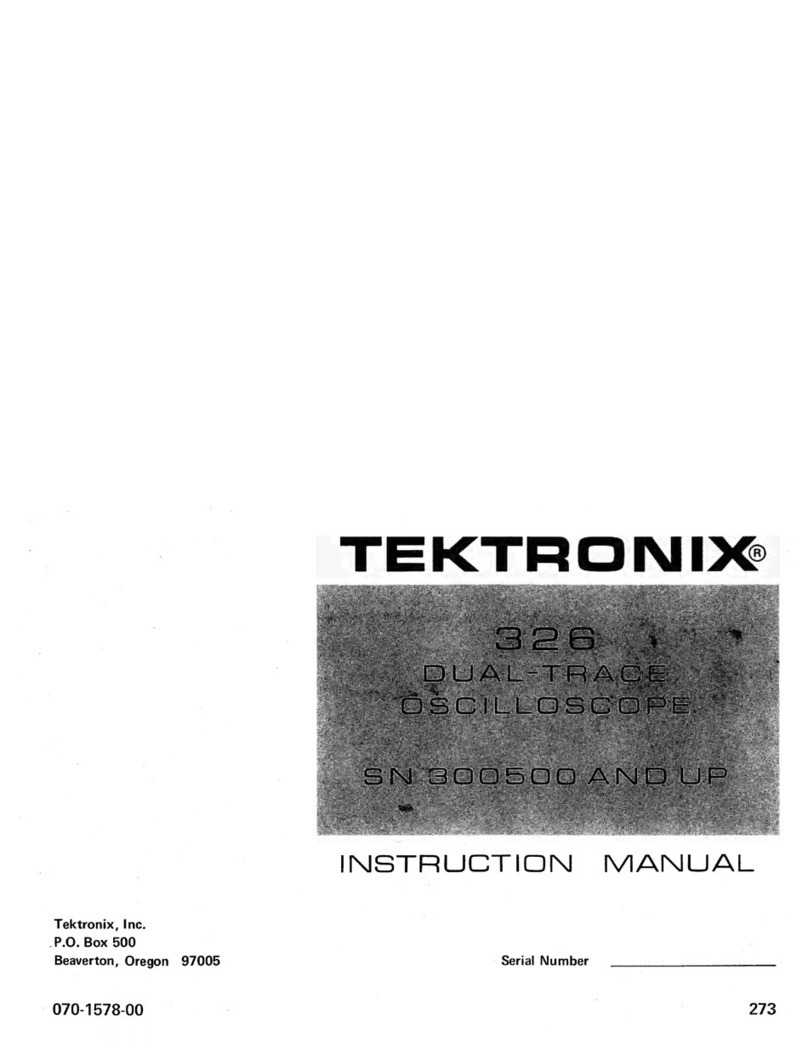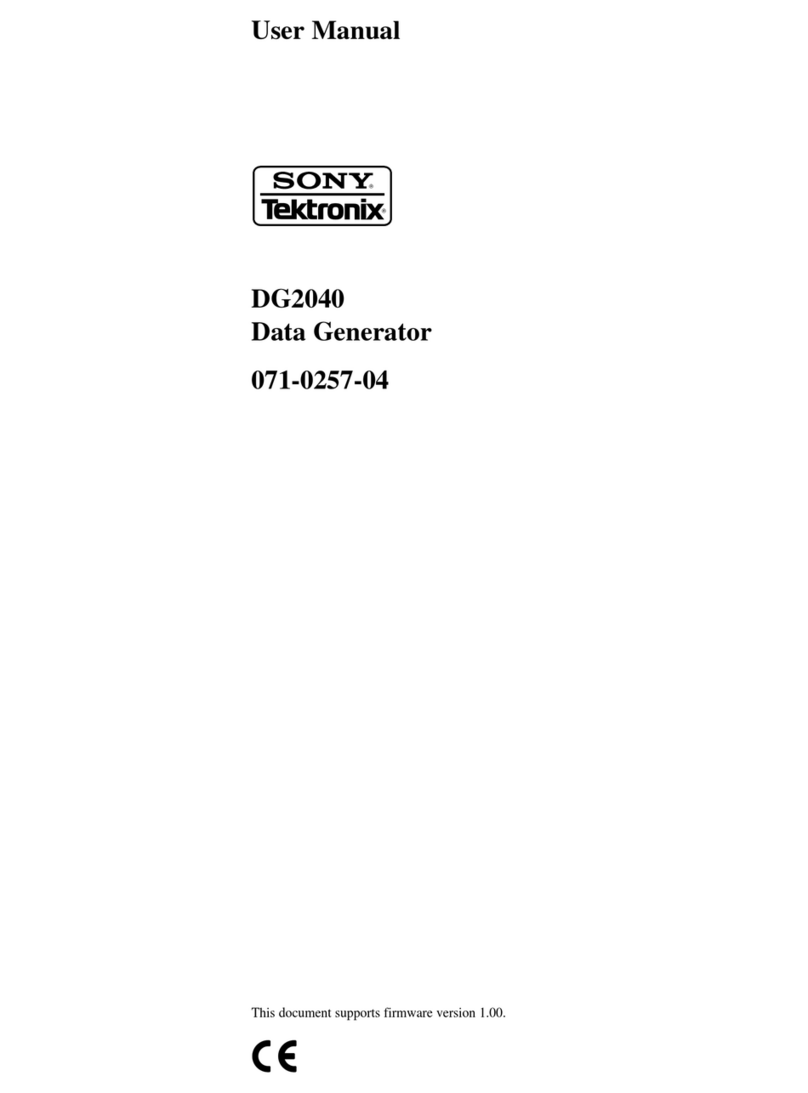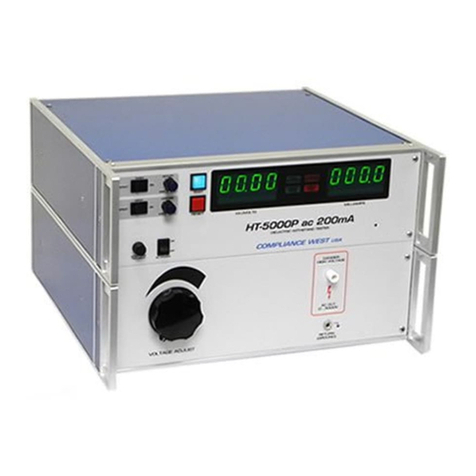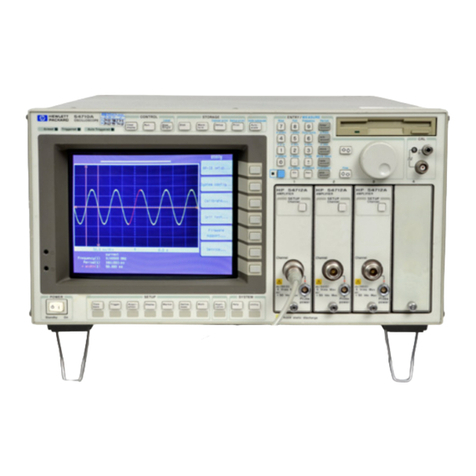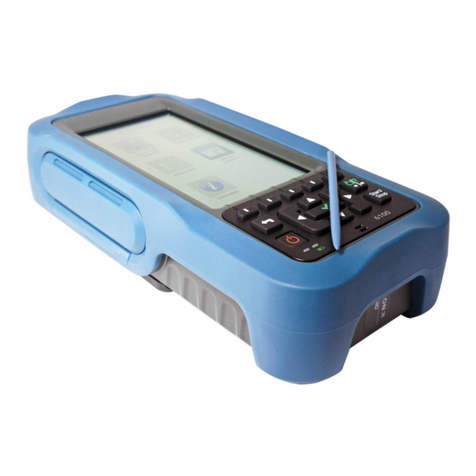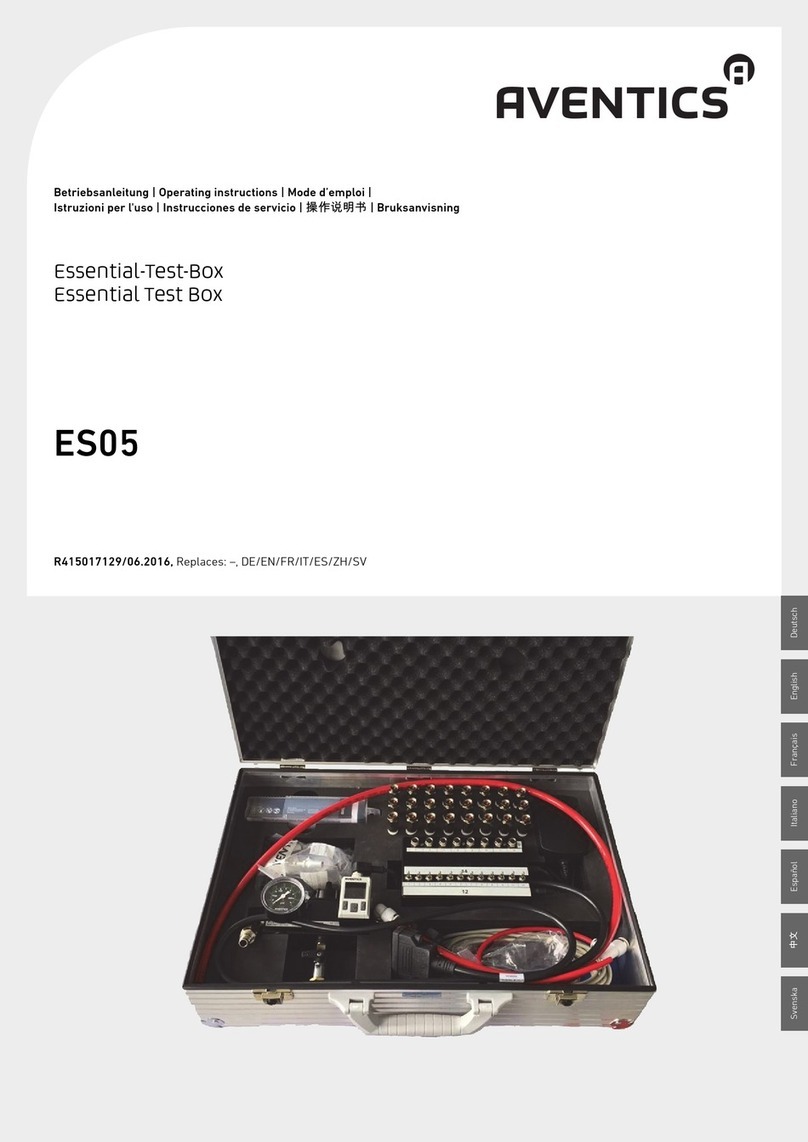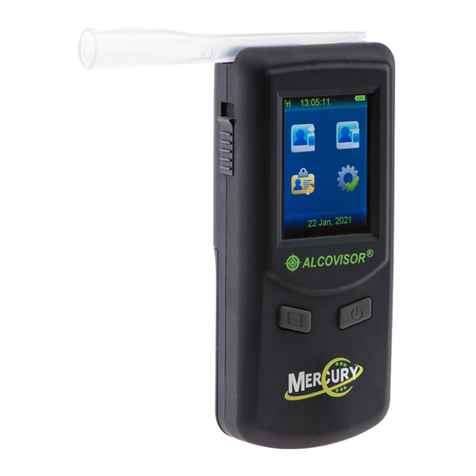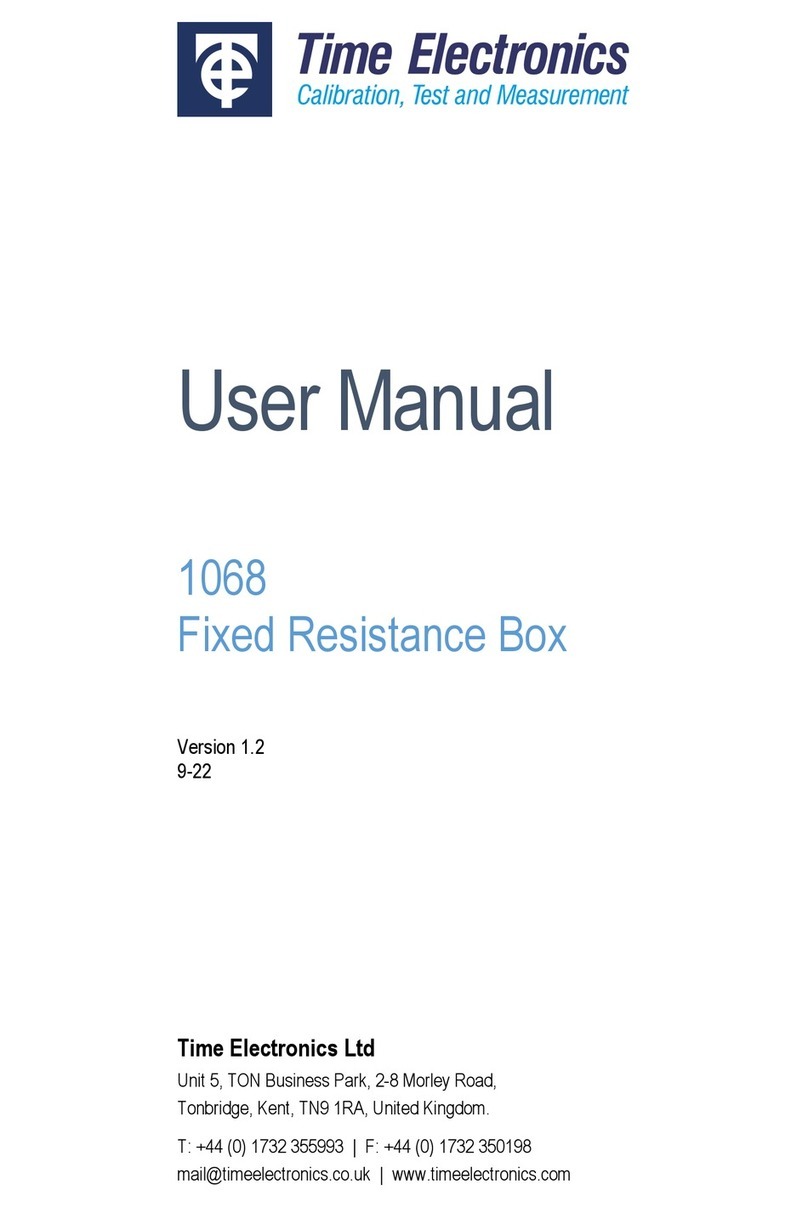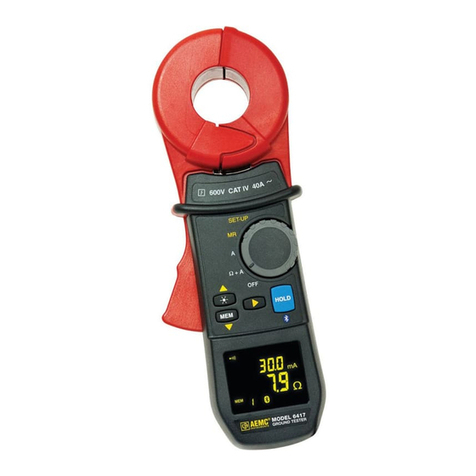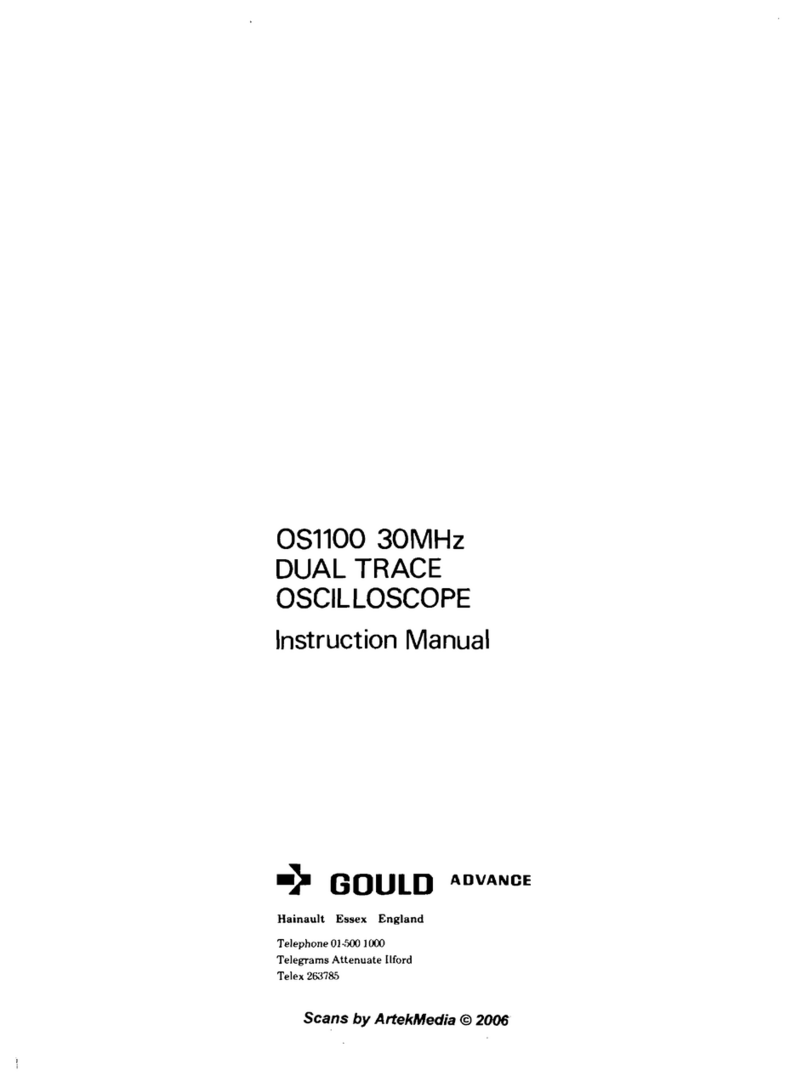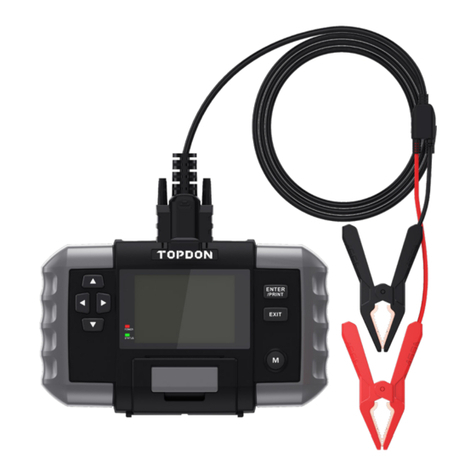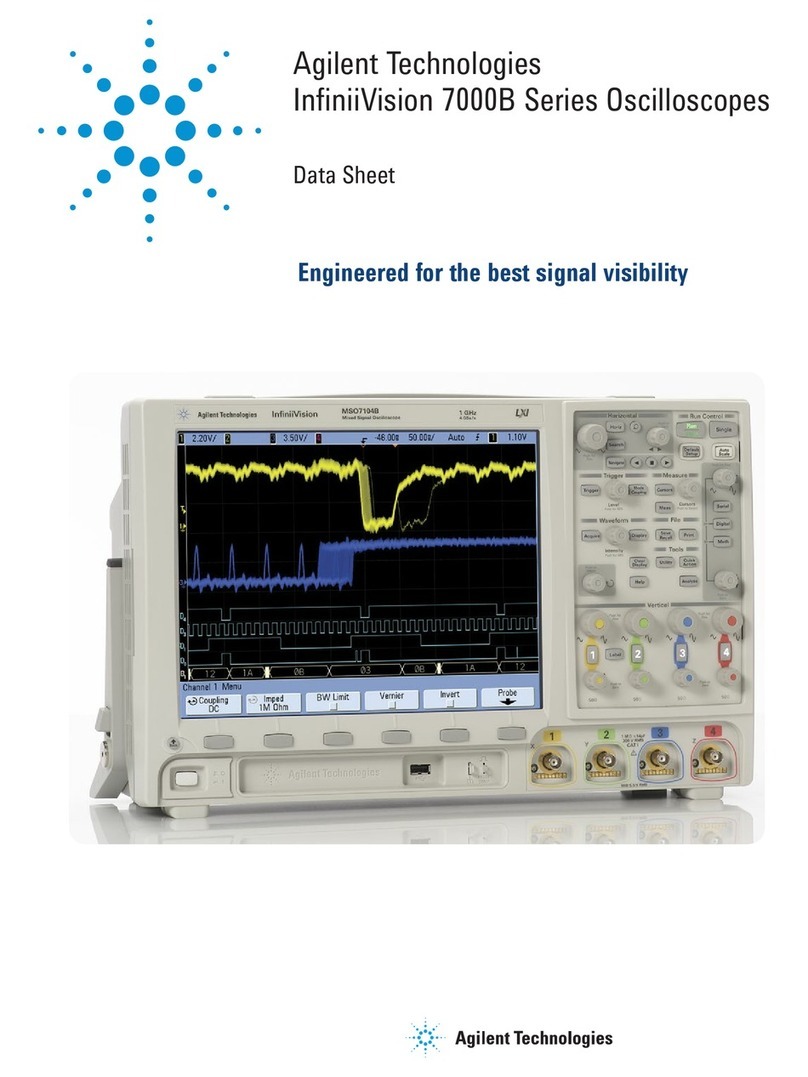Tektronix, Inc. TLS 216 User manual

Form 080/01
Complimentary Reference Material
This PDF has been made available as a complimentary service for you to assist in
evaluating this model for your testing requirements.
T G offers a wide range of test equipment solutions, from renting short to long
term, buying refurbished and purchasing new. Financing options, such as
Financial Rental, and Leasing are also available on application.
T G will assist if you are unsure whether this model will suit your requirements.
Call T G if you need to organise repair and/or calibrate your unit.
If you click on the “Click-to-Call” logo below, you can all us for FREE!
TMG Corporate Website TMG Products Website
Disclaimer:
All trademarks appearing within this PDF are trademarks of their respective owners.

User Manual
TLS 216
Logic Scope
070-8834-01
This document supports firmware version 1.0.2e
and above.

&(- .3897:2*39 2&3:+&(9:7*) '> "*09743.= -&8 & 8*7.&1 3:2'*7 43 & 5&3*1 .38*79 47 9&, 47 89&25*) 43 9-*
(-&88.8 "-* +.789 1*99*7 .3 9-* 8*7.&1 3:2'*7 )*8.,3&9*8 9-* (4:397> 4+ 2&3:+&(9:7* "-* 1&89 +.;* ).,.98 4+ 9-*
8*7.&1 3:2'*7 &7* &88.,3*) 8*6:*39.&11> &3) &7* :3.6:* 94 *&(- .3897:2*39 "-48* 2&3:+&(9:7*) .3 9-*
#3.9*) !9&9*8 -&;* 8.= :3.6:* ).,.98 "-* (4:397> 4+ 2&3:+&(9:7* .8 .)*39.+.*) &8 +4114<8
"*09743.= 3( *&;*7943 7*,43 #!
"*09743.= #3.9*) .3,)42 9) 43)43
!43>"*09743.= &5&3
"*09743.= 411&3) $ **7*3;**3 "-* *9-*71&3)8
3897:2*398 2&3:+&(9:7*) +47 "*09743.= '> *=9*73&1 ;*3)478 4:98.)* 9-* #3.9*) !9&9*8 &7* &88.,3*) & 9<4 ).,.9
&15-& (4)* 94 .)*39.+> 9-* (4:397> 4+ 2&3:+&(9:7* *, +47 &5&3 +47 43, 43, +47 87&*1 *9(
"*09743.= 3( 4= *&;*7943
7.39*) .3 #!
45>7.,-9 E"*09743.= 3( 11 7.,-98 7*8*7;*) "*09743.= 574):(98 &7* (4;*7*) '> #! &3) +47*.,3
5&9*398 .88:*) &3) 5*3).3, "-* +4114<.3, &7* 7*,.89*7*) 97&)*2&708 "" % " " &3)
!? :8472 # # &3) # &7* 97&)*2&708 4+ "*09743.=
5843 .8 & 7*,.89*7*) 97&)*2&70 4+ 5843 2*7.(& 3(
*80/*9 &8*7/*9 &3) "-.30/*9 &7* 7*,.89*7*) 97&)*2&708 4+ *<1*99?&(0&7) 47547&9.43
? &3) ? &7* 7*,.89*7*) 97&)*2&708 4+ &9.43&1 3897:2*398 47547&9.43
.8 & 7*,.89*7*) 97&)*2&70 4+ *<1*99?&(0&7) 47547&9.43
.8 & 7*,.89*7*) 97&)*2&70 4+ 39*73&9.43&1 :8.3*88 &(-.3*8
39*71*&+ .8 & 97&)*2&70 4+ 39*71*&+ 3(
.(7484+9 .8 & 7*,.89*7*) 97&)*2&70 4+ .(7484+9 47547&9.43
489!(7.59 .8 & 7*,.89*7*) 97&)*2&70 4+ )4'* !>89*28 3(47547&9*)

TLS 216 WARRANTY
" ! ! ! #
# !# " !
! ! "
!# # " " !#
# " ! "
# ! # ! "
# " #
#
!# # # #
" !# #
"
!
! #
THIS WARRANTY IS GIVEN BY TEKTRONI WITH RESPECT TO THIS PRODUCT IN LIEU OF ANY OTHER
WARRANTIES, E PRESSED OR IMPLIED. TEKTRONI AND ITS VENDORS DISCLAIM ANY IMPLIED WARRANTIES OF
MERCHANTABILITY OR FITNESS FOR A PARTICULAR PURPOSE. TEKTRONI ' RESPONSIBILITY TO REPAIR OR
REPLACE DEFECTIVE PRODUCTS IS THE SOLE AND E CLUSIVE REMEDY PROVIDED TO THE CUSTOMER FOR
BREACH OF THIS WARRANTY. TEKTRONI AND ITS VENDORS WILL NOT BE LIABLE FOR ANY INDIRECT, SPECIAL,
INCIDENTAL, OR CONSEQUENTIAL DAMAGES IRRESPECTIVE OF WHETHER TEKTRONI OR THE VENDOR HAS
ADVANCE NOTICE OF THE POSSIBILITY OF SUCH DAMAGES.
P6240 WARRANTY
" ! ! ! #
# !# " !
! ! "
!# # " " !#
# " ! "
# ! # ! "
# " #
#
!# # # #
" !# #
"
!
! #
THIS WARRANTY IS GIVEN BY TEKTRONI WITH RESPECT TO THIS PRODUCT IN LIEU OF ANY OTHER
WARRANTIES, E PRESSED OR IMPLIED. TEKTRONI AND ITS VENDORS DISCLAIM ANY IMPLIED WARRANTIES OF
MERCHANTABILITY OR FITNESS FOR A PARTICULAR PURPOSE. TEKTRONI ' RESPONSIBILITY TO REPAIR OR
REPLACE DEFECTIVE PRODUCTS IS THE SOLE AND E CLUSIVE REMEDY PROVIDED TO THE CUSTOMER FOR
BREACH OF THIS WARRANTY. TEKTRONI AND ITS VENDORS WILL NOT BE LIABLE FOR ANY INDIRECT, SPECIAL,
INCIDENTAL, OR CONSEQUENTIAL DAMAGES IRRESPECTIVE OF WHETHER TEKTRONI OR THE VENDOR HAS
ADVANCE NOTICE OF THE POSSIBILITY OF SUCH DAMAGES.


EC Declaration of Conformity
We
Tektronix Holland N.V.
Marktweg 73A
8444 AB Heerenveen
The Netherlands
declare under sole responsibility that the
TLS 216 Logic Scope
meets the intent of Directive 89/336/EEC for Electromagnetic Compatibility.
Compliance was demonstrated to the following specifications as listed in the Official
Journal of the European Communities:
EN 50081-1 Emissions:
EN 55022 Class B Radiated and Conducted Emissions
EN 60555-2 AC Power Line Harmonic Emissions
EN 50082-1 Immunity:
IEC 801-2 Electrostatic Discharge Immunity
IEC 801-3 RF Electromagnetic Field Immunity
IEC 801-4 Electrical Fast Transient/Burst Immunity
IEC 801-5 Power Line Surge Immunity


TLS 216 User Manual i
Table of Contents
List of Figures iii. . . . . . . . . . . . . . . . . . . . . . . . . . . . . . . . . . . . . . . . . . . . .
List of Tables vii. . . . . . . . . . . . . . . . . . . . . . . . . . . . . . . . . . . . . . . . . . . . . .
Safety Summary ix. . . . . . . . . . . . . . . . . . . . . . . . . . . . . . . . . . . . . . . . . . .
Preface xi. . . . . . . . . . . . . . . . . . . . . . . . . . . . . . . . . . . . . . . . . . . . . . . . . . .
Getting Started
Product Description 1–1. . . . . . . . . . . . . . . . . . . . . . . . . . . . . . . . . . . . . . . . .
Start Up 1–3. . . . . . . . . . . . . . . . . . . . . . . . . . . . . . . . . . . . . . . . . . . . . . . . . .
Setting Up for Examples 1–7. . . . . . . . . . . . . . . . . . . . . . . . . . . . . . . . . . . . .
Example 1: Displaying Waveforms 1–11. . . . . . . . . . . . . . . . . . . . . . . . . . . .
Example 2: Grouping Waveforms 1–17. . . . . . . . . . . . . . . . . . . . . . . . . . . . .
Example 3: Taking Measurements Automatically 1–23. . . . . . . . . . . . . . . .
Example 4: Saving Setups 1–29. . . . . . . . . . . . . . . . . . . . . . . . . . . . . . . . . . . .
Operating Basics
Overview 2–1. . . . . . . . . . . . . . . . . . . . . . . . . . . . . . . . . . . . . . . . . . . . . . . . . .
At a Glance 2–3. . . . . . . . . . . . . . . . . . . . . . . . . . . . . . . . . . . . . . . . . . . . . . . .
Triggering 2–13. . . . . . . . . . . . . . . . . . . . . . . . . . . . . . . . . . . . . . . . . . . . . . . . .
Acquisition 2–19. . . . . . . . . . . . . . . . . . . . . . . . . . . . . . . . . . . . . . . . . . . . . . . .
Scaling and Positioning Waveforms 2–23. . . . . . . . . . . . . . . . . . . . . . . . . . .
Measurements 2–27. . . . . . . . . . . . . . . . . . . . . . . . . . . . . . . . . . . . . . . . . . . . .
Reference
Overview 3–1. . . . . . . . . . . . . . . . . . . . . . . . . . . . . . . . . . . . . . . . . . . . . . . . . .
Adjusting the Horizontal Setup 3–3. . . . . . . . . . . . . . . . . . . . . . . . . . . . . . .
Adjusting the Vertical Setup 3–7. . . . . . . . . . . . . . . . . . . . . . . . . . . . . . . . . .
Autosetting the Logic Scope 3–13. . . . . . . . . . . . . . . . . . . . . . . . . . . . . . . . . .
Choosing an Acquisition Mode 3–17. . . . . . . . . . . . . . . . . . . . . . . . . . . . . . .
Choosing a Group Display Mode 3–23. . . . . . . . . . . . . . . . . . . . . . . . . . . . . .
Communicating with Remote Instruments 3–31. . . . . . . . . . . . . . . . . . . . . .
Customizing the Display 3–35. . . . . . . . . . . . . . . . . . . . . . . . . . . . . . . . . . . . .
Customizing the Display Colors 3–41. . . . . . . . . . . . . . . . . . . . . . . . . . . . . . .
Doing a Probe Cal 3–49. . . . . . . . . . . . . . . . . . . . . . . . . . . . . . . . . . . . . . . . . .
Doing a Signal Path Compensation 3–53. . . . . . . . . . . . . . . . . . . . . . . . . . . .
Grouping Waveforms 3–55. . . . . . . . . . . . . . . . . . . . . . . . . . . . . . . . . . . . . . .
Managing the File System 3–61. . . . . . . . . . . . . . . . . . . . . . . . . . . . . . . . . . . .

Table of Contents
ii TLS 216 User Manual
Measuring Waveforms Automatically 3–67. . . . . . . . . . . . . . . . . . . . . . . . . .
Measuring Waveforms with Cursors 3–81. . . . . . . . . . . . . . . . . . . . . . . . . . .
Printing a Hardcopy 3–87. . . . . . . . . . . . . . . . . . . . . . . . . . . . . . . . . . . . . . . .
Probing of Circuits 3–97. . . . . . . . . . . . . . . . . . . . . . . . . . . . . . . . . . . . . . . . .
Saving and Recalling Setups 3–105. . . . . . . . . . . . . . . . . . . . . . . . . . . . . . . . . .
Saving and Recalling Waveforms 3–109. . . . . . . . . . . . . . . . . . . . . . . . . . . . .
Selecting Groups and Channels 3–117. . . . . . . . . . . . . . . . . . . . . . . . . . . . . . .
Triggering After Delay 3–121. . . . . . . . . . . . . . . . . . . . . . . . . . . . . . . . . . . . . .
Triggering on Edges 3–127. . . . . . . . . . . . . . . . . . . . . . . . . . . . . . . . . . . . . . . .
Triggering on Patterns 3–131. . . . . . . . . . . . . . . . . . . . . . . . . . . . . . . . . . . . . .
Triggering on Pulses 3–141. . . . . . . . . . . . . . . . . . . . . . . . . . . . . . . . . . . . . . . .
Triggering on a Sequence 3–147. . . . . . . . . . . . . . . . . . . . . . . . . . . . . . . . . . . .
Triggering on Signals 3–159. . . . . . . . . . . . . . . . . . . . . . . . . . . . . . . . . . . . . . .
Triggering on States 3–165. . . . . . . . . . . . . . . . . . . . . . . . . . . . . . . . . . . . . . . .
Viewing Help 3–171. . . . . . . . . . . . . . . . . . . . . . . . . . . . . . . . . . . . . . . . . . . . . .
Viewing Status 3–173. . . . . . . . . . . . . . . . . . . . . . . . . . . . . . . . . . . . . . . . . . . . .
Zooming on Waveforms 3–175. . . . . . . . . . . . . . . . . . . . . . . . . . . . . . . . . . . . .
Appendices
Appendix A: Options and Accessories A–1. . . . . . . . . . . . . . . . . . . . . . . . . .
Appendix B: Algorithms B–1. . . . . . . . . . . . . . . . . . . . . . . . . . . . . . . . . . . . .
Appendix C: Packaging for Shipment C–1. . . . . . . . . . . . . . . . . . . . . . . . . .
Appendix D: Factory Initialization Settings D–1. . . . . . . . . . . . . . . . . . . . .
Glossary
Index

Table of Contents
TLS 216 User Manual iii
List of Figures
Figure 1-1: Rear Panel Controls Used in Start Up 1–4. . . . . . . . . . . . . . . .
Figure 1-2: ON/STBY Button 1–5. . . . . . . . . . . . . . . . . . . . . . . . . . . . . . . . .
Figure 1-3: Probe Connections for the Examples 1–7. . . . . . . . . . . . . . . . .
Figure 1-4: SETUP Button Location 1–8. . . . . . . . . . . . . . . . . . . . . . . . . . .
Figure 1-5: The Setup Menu 1–8. . . . . . . . . . . . . . . . . . . . . . . . . . . . . . . . . .
Figure 1-6: Trigger Controls 1–9. . . . . . . . . . . . . . . . . . . . . . . . . . . . . . . . . .
Figure 1-7: The Display After Factory Initialization 1–10. . . . . . . . . . . . . .
Figure 1-8: The Group Buttons and LEDs 1–11. . . . . . . . . . . . . . . . . . . . . .
Figure 1-9: Group Readouts 1–13. . . . . . . . . . . . . . . . . . . . . . . . . . . . . . . . . .
Figure 1-10: The VERTICAL and HORIZONTAL Controls 1–14. . . . . . .
Figure 1-11: TRIGGER Controls 1–15. . . . . . . . . . . . . . . . . . . . . . . . . . . . . .
Figure 1-12:AUTOSET Button Location 1–15. . . . . . . . . . . . . . . . . . . . . . .
Figure 1-13: The Display After Pressing Autoset 1–16. . . . . . . . . . . . . . . . .
Figure 1-14: Vertical Waveform Groups 1–18. . . . . . . . . . . . . . . . . . . . . . . .
Figure 1-15: Group 6 Displayed as a Timing Diagram 1–20. . . . . . . . . . . .
Figure 1-16: Binary Value of a Group 1–21. . . . . . . . . . . . . . . . . . . . . . . . . .
Figure 1-17: Measure Main Menu and Select Measurement
Side Menu 1–24. . . . . . . . . . . . . . . . . . . . . . . . . . . . . . . . . . . . . . . . . . . . .
Figure 1-18: Four Simultaneous Measurement Readouts 1–25. . . . . . . . . .
Figure 1-19: General Purpose Knob Indicators 1–26. . . . . . . . . . . . . . . . . .
Figure 1-20: Snapshot of Channel 2 1–28. . . . . . . . . . . . . . . . . . . . . . . . . . .
Figure 1-21: Save/Recall Setup Menu 1–30. . . . . . . . . . . . . . . . . . . . . . . . . .
Figure 2-1: Triggered Versus Untriggered Displays 2–13. . . . . . . . . . . . . . .
Figure 2-2: Trigger Holdoff Time Ensures Valid Triggering 2–16. . . . . . . .
Figure 2-3: Slope and Level Controls Help Define the Trigger 2–17. . . . . .
Figure 2-4:Acquisition: Input Analog Signal, Sample, and
Digitize 2–19. . . . . . . . . . . . . . . . . . . . . . . . . . . . . . . . . . . . . . . . . . . . . . . .
Figure 2-5: Real-Time Sampling 2–20. . . . . . . . . . . . . . . . . . . . . . . . . . . . . .
Figure 2-6: Scaling and Positioning 2–23. . . . . . . . . . . . . . . . . . . . . . . . . . . .
Figure 2-7: Aliasing 2–25. . . . . . . . . . . . . . . . . . . . . . . . . . . . . . . . . . . . . . . . .
Figure 2-8: Graticule, Cursor, and Automated Measurements 2–27. . . . .
Figure 2-9: Cursor Modes 2–28. . . . . . . . . . . . . . . . . . . . . . . . . . . . . . . . . . . .
Figure 3-1: Horizontal Controls 3–3. . . . . . . . . . . . . . . . . . . . . . . . . . . . . . .
Figure 3-2: Record View and Time Base Readout 3–4. . . . . . . . . . . . . . . .
Figure 3-3: Vertical Controls 3–8. . . . . . . . . . . . . . . . . . . . . . . . . . . . . . . . .

Table of Contents
iv TLS 216 User Manual
Figure 3-4: Vertical Readout and Vertical Controls Menu 3–10. . . . . . . . .
Figure 3-5: How the Acquisition Modes Work 3–18. . . . . . . . . . . . . . . . . . .
Figure 3-6:Acquisition Menu and Readout 3–19. . . . . . . . . . . . . . . . . . . . .
Figure 3-7:Acquire Menu — Stop After 3–20. . . . . . . . . . . . . . . . . . . . . . . .
Figure 3-8: Display Modes 3–24. . . . . . . . . . . . . . . . . . . . . . . . . . . . . . . . . . .
Figure 3-9: Snapshot of Group Status 3–25. . . . . . . . . . . . . . . . . . . . . . . . . .
Figure 3-10: Group Display Mode Menu 3–26. . . . . . . . . . . . . . . . . . . . . . .
Figure 3-11: Group Display Mode Set to Analog Select 3–27. . . . . . . . . . .
Figure 3-12: Typical GPIB Network Configuration 3–32. . . . . . . . . . . . . . .
Figure 3-13: Stacking GPIB Connectors 3–32. . . . . . . . . . . . . . . . . . . . . . . .
Figure 3-14: Connecting the Logic Scope to a Controller 3–33. . . . . . . . . .
Figure 3-15: Utility Menu 3–34. . . . . . . . . . . . . . . . . . . . . . . . . . . . . . . . . . . .
Figure 3-16: Snapshot of Display Status 3–35. . . . . . . . . . . . . . . . . . . . . . . .
Figure 3-17: Display Menu — Style Settings 3–36. . . . . . . . . . . . . . . . . . . .
Figure 3-18: Trigger Point and Level Indicators 3–38. . . . . . . . . . . . . . . . .
Figure 3-19: Snapshot of Display Status 3–41. . . . . . . . . . . . . . . . . . . . . . . .
Figure 3-20: Display Menu — Color Settings 3–42. . . . . . . . . . . . . . . . . . . .
Figure 3-21: Display Menu — Change Colors 3–44. . . . . . . . . . . . . . . . . . .
Figure 3-22: Display Menu — Map Group Colors 3–45. . . . . . . . . . . . . . . .
Figure 3-23: Display Menu — Restore Colors 3–46. . . . . . . . . . . . . . . . . . .
Figure 3-24: Probe Cal Menu and Probe Cal Display 3–51. . . . . . . . . . . . .
Figure 3-25: Performing a Signal Path Compensation 3–54. . . . . . . . . . . .
Figure 3-26: Groups — Valid and Invalid 3–56. . . . . . . . . . . . . . . . . . . . . . .
Figure 3-27: Vertical Readout Displaying Two Group Readouts 3–57. . . .
Figure 3-28: The Group Definition Menu 3–58. . . . . . . . . . . . . . . . . . . . . . .
Figure 3-29: File Utilities Menu and Listing 3–62. . . . . . . . . . . . . . . . . . . . .
Figure 3-30: File System — Labelling Menu 3–64. . . . . . . . . . . . . . . . . . . .
Figure 3-31: Measurement Readouts 3–68. . . . . . . . . . . . . . . . . . . . . . . . . . .
Figure 3-32: Measure Menu 3–71. . . . . . . . . . . . . . . . . . . . . . . . . . . . . . . . . .
Figure 3-33: Measure Menu — Gating 3–72. . . . . . . . . . . . . . . . . . . . . . . . .
Figure 3-34: Measure Menu — Reference Levels 3–74. . . . . . . . . . . . . . . .
Figure 3-35: Measure Delay Menu — Delay To 3–75. . . . . . . . . . . . . . . . . .
Figure 3-36: Measure Setup Menu 3–77. . . . . . . . . . . . . . . . . . . . . . . . . . . .
Figure 3-37: Snapshot Menu and Readout 3–79. . . . . . . . . . . . . . . . . . . . . .
Figure 3-38: Cursor Types 3–81. . . . . . . . . . . . . . . . . . . . . . . . . . . . . . . . . . .
Figure 3-39: Cursor Modes 3–82. . . . . . . . . . . . . . . . . . . . . . . . . . . . . . . . . . .
Figure 3-40: Vertical Bar Cursor Readout (With Binary Readout) 3–83. .
Figure 3-41: Cursor Menu and Readouts — Paired Cursors
Selected 3–84. . . . . . . . . . . . . . . . . . . . . . . . . . . . . . . . . . . . . . . . . . . . . . . .

Table of Contents
TLS 216 User Manual v
Figure 3-42: Utility Menu — System I/O 3–88. . . . . . . . . . . . . . . . . . . . . . .
Figure 3-43: Hardcopy Formats 3–89. . . . . . . . . . . . . . . . . . . . . . . . . . . . . . .
Figure 3-44: Date and Time Display 3–90. . . . . . . . . . . . . . . . . . . . . . . . . . .
Figure 3-45: Connecting the Logic Scope Directly to the
Hardcopy Device 3–91. . . . . . . . . . . . . . . . . . . . . . . . . . . . . . . . . . . . . . . .
Figure 3-46: Connecting the Logic Scope and Hardcopy Device
Via a PC 3–93. . . . . . . . . . . . . . . . . . . . . . . . . . . . . . . . . . . . . . . . . . . . . . .
Figure 3-47: Basic Probe Connection 3–98. . . . . . . . . . . . . . . . . . . . . . . . . .
Figure 3-48: Installing Accessories — Standard and Optional 3–99. . . . . .
Figure 3-49:A Probe Adds Resistance, Capacitance, and
Inductance 3–103. . . . . . . . . . . . . . . . . . . . . . . . . . . . . . . . . . . . . . . . . . . . .
Figure 3-50: Signal Variation Introduced by Probe Ground Lead
(1 ns/division) 3–103. . . . . . . . . . . . . . . . . . . . . . . . . . . . . . . . . . . . . . . . . . .
Figure 3-51: Save/Recall Setup Menu 3–105. . . . . . . . . . . . . . . . . . . . . . . . . .
Figure 3-52: Save Group Menu 3–111. . . . . . . . . . . . . . . . . . . . . . . . . . . . . . .
Figure 3-53: Save Group to File Menu 3–112. . . . . . . . . . . . . . . . . . . . . . . . .
Figure 3-54: More Menu for Displaying Reference Groups 3–113. . . . . . . .
Figure 3-55: The Vertical Readout 3–118. . . . . . . . . . . . . . . . . . . . . . . . . . . . .
Figure 3-56: Delayed Runs After Main 3–121. . . . . . . . . . . . . . . . . . . . . . . . .
Figure 3-57: Delayed Triggerable 3–122. . . . . . . . . . . . . . . . . . . . . . . . . . . . .
Figure 3-58: How the Delayed Triggers Work 3–123. . . . . . . . . . . . . . . . . . .
Figure 3-59: Delayed Trigger Menu 3–125. . . . . . . . . . . . . . . . . . . . . . . . . . .
Figure 3-60: Snapshot of Trigger Status 3–128. . . . . . . . . . . . . . . . . . . . . . . .
Figure 3-61: Main Trigger Menu — Edge Type 3–129. . . . . . . . . . . . . . . . . .
Figure 3-62: Snapshot of Trigger Status 3–134. . . . . . . . . . . . . . . . . . . . . . . .
Figure 3-63: Pattern Trigger Menu 3–135. . . . . . . . . . . . . . . . . . . . . . . . . . . .
Figure 3-64: Triggering on a Pattern: Time Out Qualified 3–137. . . . . . . . .
Figure 3-65: Time-Qualified Pattern Triggering: > Time 3–138. . . . . . . . . .
Figure 3-66: Pulse Trigger Readouts 3–142. . . . . . . . . . . . . . . . . . . . . . . . . . .
Figure 3-67: Pulse Trigger Menu 3–143. . . . . . . . . . . . . . . . . . . . . . . . . . . . . .
Figure 3-68: Trigger Readout 3–150. . . . . . . . . . . . . . . . . . . . . . . . . . . . . . . . .
Figure 3-69: Sequence Trigger Menu 3–151. . . . . . . . . . . . . . . . . . . . . . . . . .
Figure 3-70: Triggering on a Sequence: > Time, Minimum Time
Qualification 3–155. . . . . . . . . . . . . . . . . . . . . . . . . . . . . . . . . . . . . . . . . . .
Figure 3-71: Time-Qualified Pattern Triggering: Time Out 3–156. . . . . . . .
Figure 3-72: TRIGGER Controls and Status Lights 3–159. . . . . . . . . . . . . .
Figure 3-73: Trigger Type, Record View, Trigger Position, and
Trigger Level Bar Readouts 3–161. . . . . . . . . . . . . . . . . . . . . . . . . . . . . . .
Figure 3-74: Snapshot of Trigger Status 3–166. . . . . . . . . . . . . . . . . . . . . . . .
Figure 3-75: State Trigger Menu 3–167. . . . . . . . . . . . . . . . . . . . . . . . . . . . . .

Table of Contents
vi TLS 216 User Manual
Figure 3-76: Initial Help Screen 3–171. . . . . . . . . . . . . . . . . . . . . . . . . . . . . . .
Figure 3-77: Status Menu — System 3–173. . . . . . . . . . . . . . . . . . . . . . . . . . .
Figure 3-78: Zoom Mode with Horizontal Lock Set to All 3–177. . . . . . . . .
Figure B–1: MCross Calculations B–4. . . . . . . . . . . . . . . . . . . . . . . . . . . . .
Figure B–2: Fall Time B–7. . . . . . . . . . . . . . . . . . . . . . . . . . . . . . . . . . . . . . .
Figure B–3: Hold Time B–8. . . . . . . . . . . . . . . . . . . . . . . . . . . . . . . . . . . . . .
Figure B–4: Rise Time B–12. . . . . . . . . . . . . . . . . . . . . . . . . . . . . . . . . . . . . . .
Figure B–5: Setup Time B–14. . . . . . . . . . . . . . . . . . . . . . . . . . . . . . . . . . . . .
Figure B–6: Skew Time B–15. . . . . . . . . . . . . . . . . . . . . . . . . . . . . . . . . . . . . .
Figure B–7: Choosing Minima or Maxima to Use for Envelope
Measurements B–16. . . . . . . . . . . . . . . . . . . . . . . . . . . . . . . . . . . . . . . . . .

Table of Contents
TLS 216 User Manual vii
List of Tables
Table 1–1: Fuse and Fuse Cap Part Numbers 1–4. . . . . . . . . . . . . . . . . . .
Table 3–1: Autoset Defaults 3–15. . . . . . . . . . . . . . . . . . . . . . . . . . . . . . . . . .
Table 3–2: Logic Family Presets 3–29. . . . . . . . . . . . . . . . . . . . . . . . . . . . . . .
Table 3–3: Measurement Definitions 3–68. . . . . . . . . . . . . . . . . . . . . . . . . .
Table 3–4: Probe-Related Accessories 3–100. . . . . . . . . . . . . . . . . . . . . . . . .
Table 3–5: Group Selection Priority 3–120. . . . . . . . . . . . . . . . . . . . . . . . . . .
Table 3–6: Logic Qualifiers 3–131. . . . . . . . . . . . . . . . . . . . . . . . . . . . . . . . . .
Table 3–7: Time Qualifiers 3–132. . . . . . . . . . . . . . . . . . . . . . . . . . . . . . . . . .
Table 3–8: Pulse Trigger Definitions 3–142. . . . . . . . . . . . . . . . . . . . . . . . . . .
Table 3–9: Logic Functions 3–148. . . . . . . . . . . . . . . . . . . . . . . . . . . . . . . . . .
Table 3–10: Time Qualifiers 3–148. . . . . . . . . . . . . . . . . . . . . . . . . . . . . . . . .
Table 3–11: State Triggers 3–165. . . . . . . . . . . . . . . . . . . . . . . . . . . . . . . . . . .
Table 3–12: Zoom Defaults 3–178. . . . . . . . . . . . . . . . . . . . . . . . . . . . . . . . . .
Table A–1: International Power Cords A–1. . . . . . . . . . . . . . . . . . . . . . . .
Table A–2: Standard Accessories A–2. . . . . . . . . . . . . . . . . . . . . . . . . . . . .
Table A–3: Optional Accessories A–3. . . . . . . . . . . . . . . . . . . . . . . . . . . . . .
Table A–4: Accessory Software A–4. . . . . . . . . . . . . . . . . . . . . . . . . . . . . . .
Table D–1: Factory Initialization Defaults D–1. . . . . . . . . . . . . . . . . . . . . .

Table of Contents
viii TLS 216 User Manual

TLS 216 User Manual ix
Safety Summary
Please take a moment to review these safety precautions. They are provided for
your protection and to prevent damage to the logic scope. This safety informa-
tion applies to all operators and service personnel.
Symbols and Terms
These two terms appear in manuals:
CAUTION. These statements identify conditions or practices that could result in
damage to the equipment or other property.
WARNING. These statements identify conditions or practices that could result in
personal injury or loss of life.
These two terms appear on equipment:
HCAUTION indicates a personal injury hazard not immediately accessible as
one reads the marking or a hazard to property including the equipment itself.
HDANGER indicates a personal injury hazard immediately accessible as one
reads the marking.
This symbol appears in manuals:
Static-Sensitive Devices
These symbols appear on equipment:
DANGER
High Voltage Protectiveground
(earth)terminal ATTENTION
Referto
manual

Safety Summary
xTLS 216 User Manual
Specific Precautions
Observe all of these precautions to ensure your personal safety and to prevent
damage to either the logic scope or equipment connected to it.
The logic scope is intended to operate from a power source that will not apply
more than 250 VRMS between the supply conductors or between either supply
conductor and ground. A protective ground connection, through the grounding
conductor in the power cord, is essential for safe system operation.
The logic scope is grounded through the power cord. To avoid electric shock,
plug the power cord into a properly wired receptacle where earth ground has
been verified by a qualified service person. Do this before making connections to
the input or output terminals of the logic scope.
Without the protective ground connection, all parts of the logic scope are
potential shock hazards. This includes knobs and controls that may appear to be
insulators.
Use only the power cord and connector specified for your product. Use only a
power cord that is in good condition.
To avoid fire hazard, use only the fuse specified in the parts list for your product,
matched by type, voltage rating, and current rating.
To avoid personal injury, do not operate the logic scope without the panels or
covers.
Never apply a voltage to a connector on the logic scope that is outside the
voltage range specified for that connector.
The logic scope provides no explosion protection from static discharges or arcing
components. Do not operate the logic scope in an atmosphere of explosive gases.
To prevent overheating, keep the logic scope ventilation holes free from
obstruction.
If you suspect the logic scope is damaged, have it inspected by a qualified
service person.
Power Source
Grounding the Logic
Scope
Use the Proper Power
Cord
Use the Proper Fuse
Do Not Remove Covers or
Panels
Electric Overload
Do Not Operate in
Explosive Atmospheres
Provide Proper Ventilation
Do Not Operate With
Suspected Failures

TLS 216 User Manual xi
Preface
This is the User Manual for the TLS 216 Logic Scope.
Section 1 Getting Started familiarizes you with the operation of your logic
scope.
Section 2 Operating Basics covers basic principles of the operation of the logic
scope. The topics covered help you understand why your logic scope operates
the way it does.
Section 3 Reference teaches you how to perform specific tasks. See page 3–1 for
a complete list of tasks covered in that section.
The Appendices provide an options listing, an accessories listing, and other
useful information.
Conventions
In the Getting Started and Reference sections, you will find various procedures
which contain steps of instructions for you to perform. To keep those instructions
clear and consistent, this manual uses the following conventions:
HNames of front-panel controls and menu labels appear in boldface print.
HNames also appear in the same case (initial capitals, all uppercase, etc.) in
the manual as is used on the logic scope front panel and menus. Front panel
names are all upper case letters, for example, GROUP MENU and
GROUP 1.
HInstruction steps are numbered. The number is omitted if there is only one
step.
HWhen steps require that you make a sequence of selections using front-panel
controls and menu buttons, an arrow ( ➞) marks each transition between a
front panel button and a menu, or between menus. Also, whether a name is a
main menu or side menu item is clearly indicated: Press HORIZONTAL
MENU ➞Record Length (main) ➞500 points in 10 divs (side) ➞
Trigger Position (main) ➞Set to 20% (side).
Using the convention just described results in instructions that are graphically
intuitive and simplifies procedures. For example, the instruction just given
replaces these five steps:
1. Press the front-panel button HORIZONTAL MENU.
2. Press the main menu button Record Length.

Preface
xii TLS 216 User Manual
3. Press the side menu button 500 points in 10 divs.
4. Press the main menu button Trigger Position
5. Press the side menu button Set to 20%
Sometimes you may have to make a selection from a popup menu: Press
TRIGGER MENU ➞Type (main) ➞Edge (pop-up). In this example, you
repeatedly press the main menu button Type until Edge is highlighted in the
pop-up menu.
Related Manuals
The following documents are related to the use or service of the logic scope.
HThe TLS 216 Programmer Manual (Tektronix part number 070-8835-XX)
describes using a computer to control the logic scope through the GPIB
interface.
HThe TLS 216 Reference (Tektronix part number 070-8833-XX) gives you a
quick overview of how to operate your logic scope.
HThe TLS 216 Performance Verification and Specifications Technical
Reference (Tektronix part number 070-8832-XX) tells how to verify the
performance of the logic scope.
HThe TLS 216 Service Manual (Tektronix part number 070-8831-XX)
provides information for maintaining and servicing your logic scope to the
module level.

Getting Started
This manual suits for next models
1
Table of contents
Other Tektronix, Inc. Test Equipment manuals
Popular Test Equipment manuals by other brands
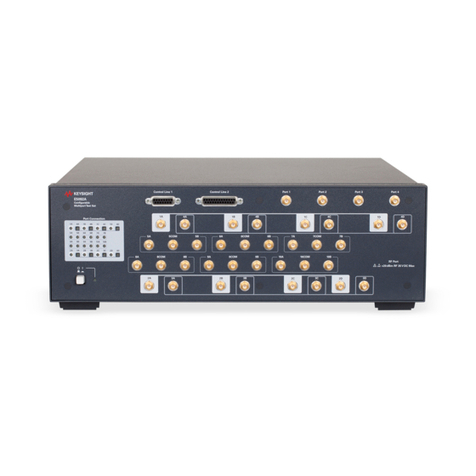
Agilent Technologies
Agilent Technologies ENA Series Service guide
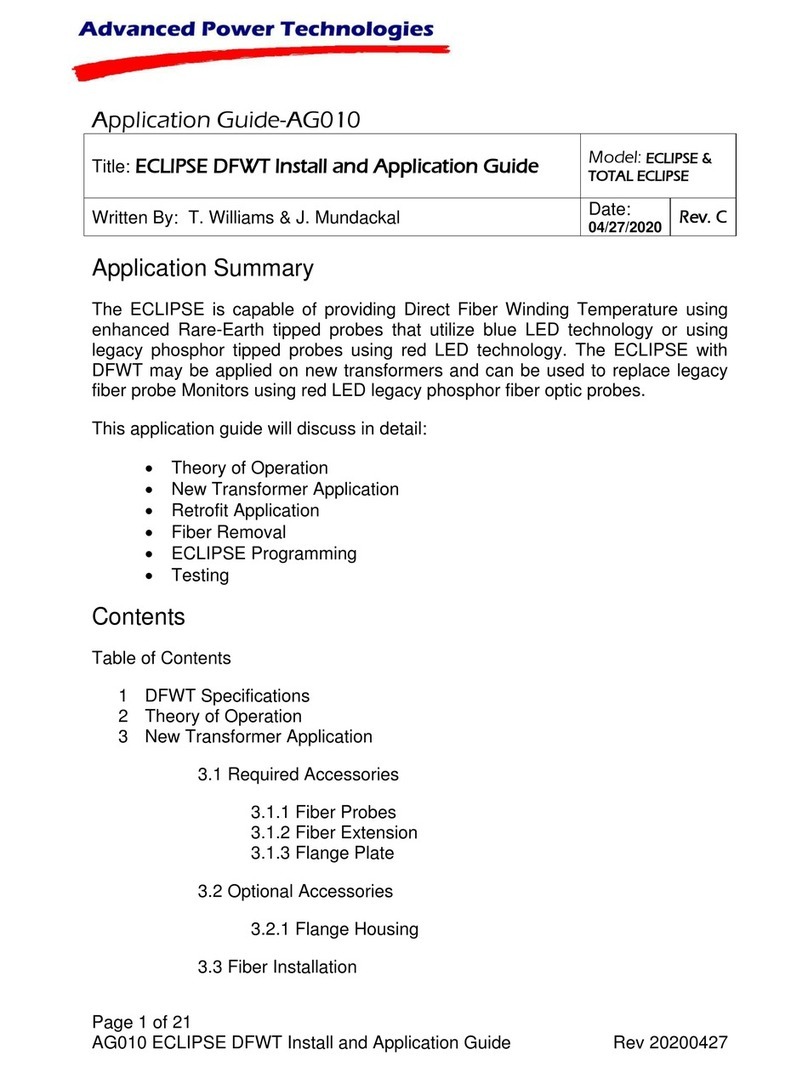
Advanced Power technologies
Advanced Power technologies ECLIPSE Application guide
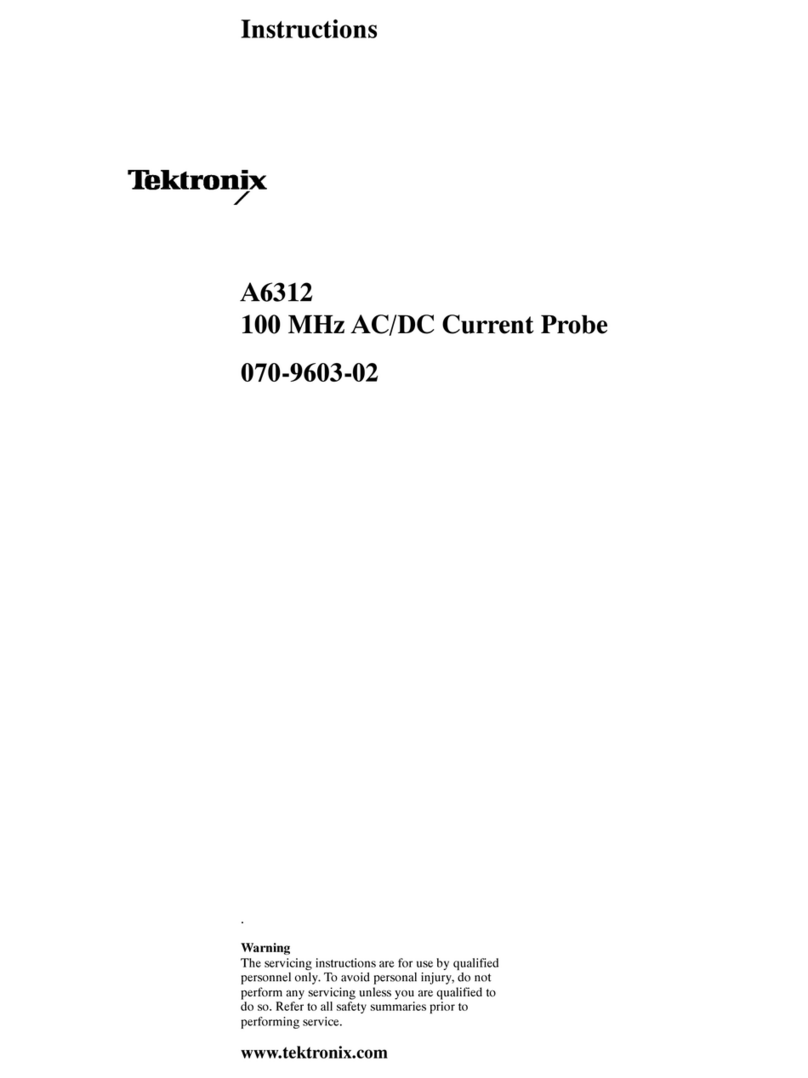
Tektronix
Tektronix A6312 instructions
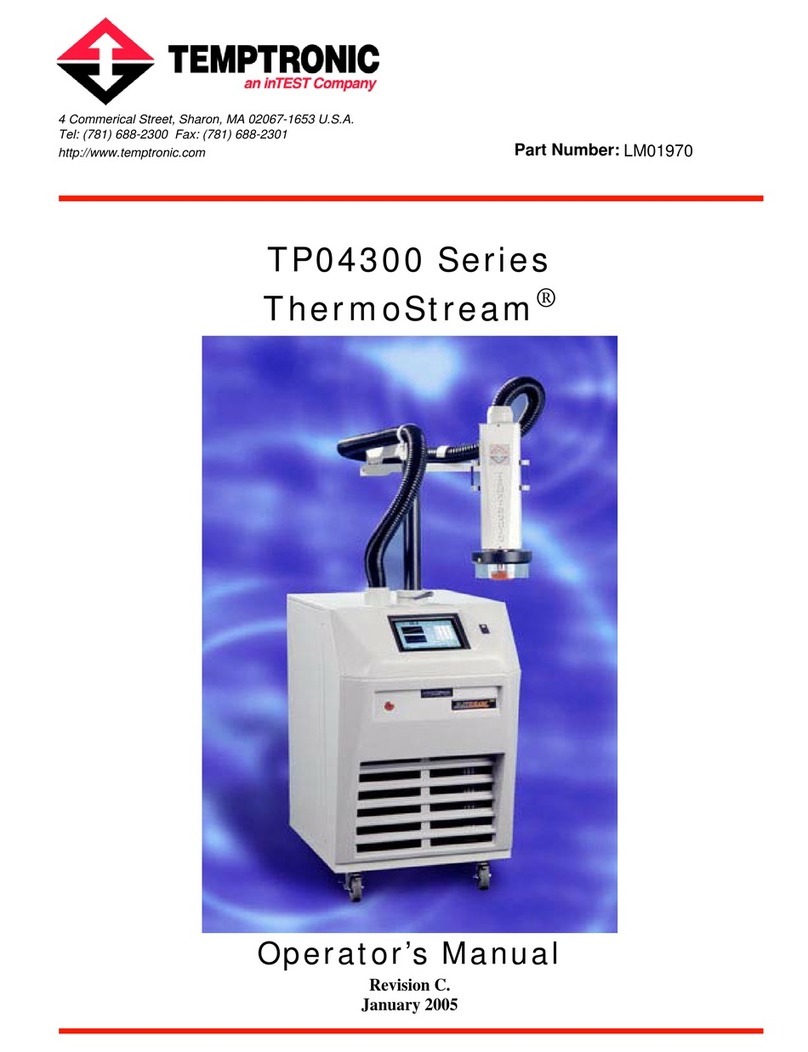
inTest
inTest Temptronic ThermoStream TP04300 Series Operator's manual
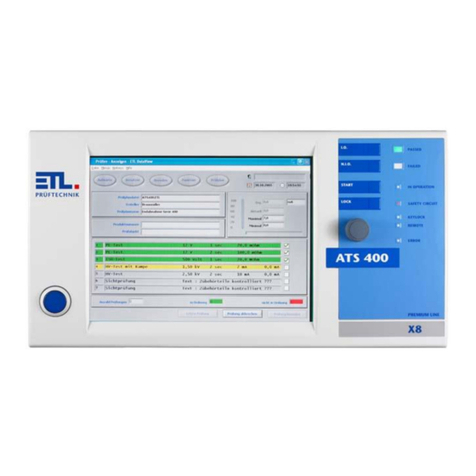
ETL
ETL ATS 400 instruction manual
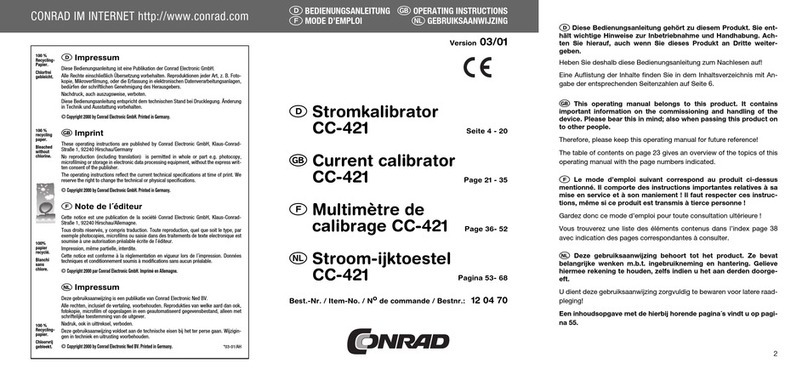
Conrad
Conrad CC-421 operating instructions
